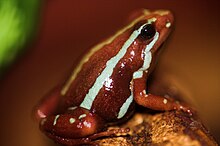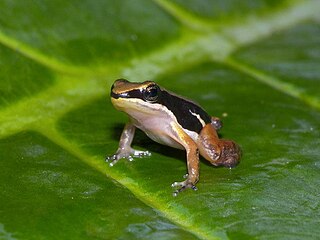
Colostethus is a genus of poison dart frogs native to Central and South America, from Panama south to Colombia, Ecuador, and northern Peru. Their common name is rocket frogs, but this name may refer to frogs in other genera and families, following the taxonomic revision of the genus in 2006.

Dendrobates is a genus of poison dart frogs native to Central and South America. It once contained numerous species, but most originally placed in this genus have been split off into other genera such as Adelphobates, Ameerega, Andinobates, Epipedobates, Excidobates, Oophaga, Phyllobates and Ranitomeya, leaving only five large to medium-sized species in the genus Dendrobates. All the other genera used to be grouped in with Dendrobates because it was previously thought that all brightly colored poison dart frogs came from the same ancestor but this has since been proven to be incorrect. Dendrobates and Phyllobates evolved conspicuous coloration from the same common ancestor but not the same as any of the other genera listed above.
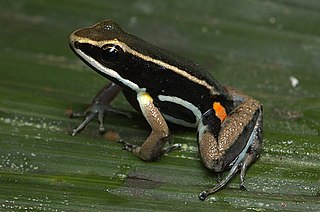
The Aromobatidae are a family of frogs native to Central and South America. They are sometimes referred to as cryptic forest frogs or cryptic poison frogs. They are the sister taxon of the Dendrobatidae, the poison dart frogs, but are not as toxic as most dendrobatids are.
Hyloxalus cevallosi, also known as Palanda rocket frog, is a species of poison dart frogs in the family Dendrobatidae. It is named after Gabriel Cevallos García, a famous Ecuadorean writer. This species of frog occurs on the east side of the Andes in Ecuador in the Pastaza Province. Its natural habitats are very humid premontane and pluvial premontane forests.

Rheobates palmatus is a species of frog in the family Aromobatidae. It is the type species of genus Rheobates erected in 2006. Its common name is palm rocket frog. It is endemic to Colombia. It is considered to be part of a species complex.

The blue-bellied poison frog or bluebelly poison frog is a species of frog in the family Dendrobatidae.
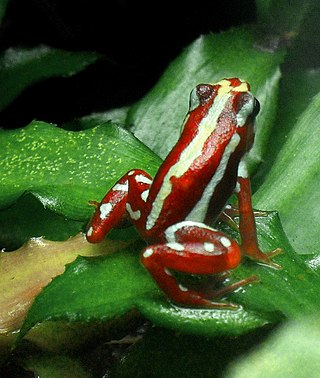
Anthony's poison arrow frog is a species of poison dart frog in the family Dendrobatidae. The species is endemic to Ecuador and Peru.
The marbled poison frog or marbled poison-arrow frog is a species of frog in the family Dendrobatidae found in western Colombia and northwestern Ecuador, at elevations of 10–1,500 m (33–4,921 ft) asl. It likely represents a species complex of at least two species.
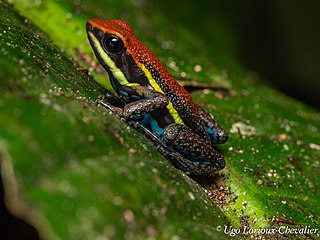
The Cainarachi poison frog is a species of frogs in the family Dendrobatidae. It is endemic to Amazonian Peru and found in the lowlands adjacent to the northern end of the Eastern Andes. It was named after the Rio Cainarache Valley, where it was first discovered.
The Oxapampa poison frog is a species of frog in the family Dendrobatidae endemic to Peru near Oxapampa, in the Pasco Region. Its natural habitat is montane tropical rainforest. It is a very rare species threatened by habitat loss.

Hyloxalus is a genus of poison dart frogs, family Dendrobatidae. The genus is distributed in Central and South America, from Panama south to Peru, along with Venezuela, Colombia, and Ecuador. They also inhabit the eastern foothills of the Andes in Bolivia to Venezuela, east to the upper Amazon Basin.

Ameerega is a genus of poison dart frogs in the family Dendrobatidae. These frogs live around rocks that are nearby streams. They are found in central South America north to Panama. It contains many former species of the genus Epipedobates.

Silverstoneia is a genus of poison dart frogs from southern Central America and northern South America, between southwestern Costa Rica and southwestern Colombia. It is named in honour of Phillip A. Silverstone, an expert on dendrobatoid frogs.

Adelphobates is a small genus of poison dart frogs. They are found in the central and lower Amazon basin of Peru and Brazil, possibly Bolivia. It was originally erected as a sister group to the Dendrobates and Oophaga genera. The validity of the genus is still being discussed, with the alternative being "Dendrobates galactonotus group" within Dendrobates. One species originally placed in this genus as Adelphobates captivus has since been moved to the genus Excidobates erected in 2008.
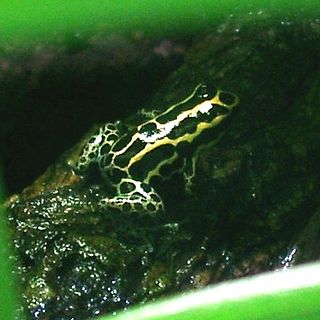
Ranitomeya is a genus of dart poison frogs found in Panama and South America south to Peru and Brazil, possibly into Bolivia.

Andinobates is a genus of poison dart frogs from Ecuador, Colombia and Panama. It contains species formerly classified in the genus Dendrobates and in 2006 transferred to the genus Ranitomeya. In 2011 Twomey, Brown, and their colleagues erected the genus Andinobates for a group of 12 species of Ranitomeya. Andinobates frogs can be distinguished from their sister taxon Ranitomeya anatomically in that their 2nd and 3rd vertebrae are fused. They show no limb reticulation, which is present in most species of Ranitomeya.

Anomaloglossus is a genus of frogs in the family Aromobatidae. The genus is endemic to the Guiana Shield in northern South America. It used to be placed in the family Dendrobatidae, and is still placed in that family by some sources. The name of the genus, from the Greek anomalos and glossa (=tongue), refers to the unusual tongue bearing the median lingual process, the only unambiguous phenotypic synapomorphy of this genus.
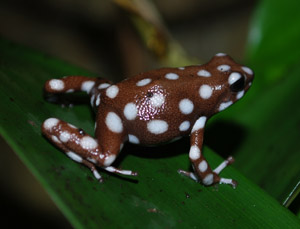
Excidobates is a genus of poison dart frogs endemic to the Marañón River drainage in Peru and Ecuador, South America. At one time members of this genus were classified as Dendrobates. A characteristic of this genus is the presence of pale, ovoid spots on the under surface of the thighs.

Rheobates is a genus of frogs in the family Aromobatidae. It is endemic to Colombia. These are cryptically coloured frogs with extensive toe webbing. The name Rheobates is derived from the Greek words rheo and βάτης bátēs, in reference to the riparian habitat of the type species Rheobates palmatus. They are associated with streams in sub-Andean forests and foothills of the Andes at low to medium altitudes.
Epipedobates narinensis is a species of poison dart frog. It was first described as a distinct species in 2008.
